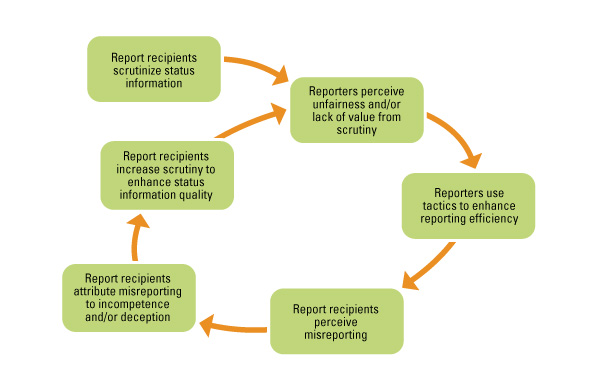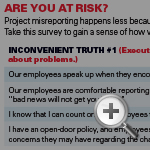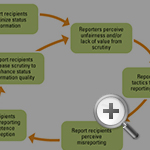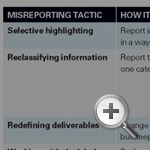The Pitfalls of Project Status Reporting
Will your next big IT project be on time and deliver what was promised? Maybe — but maybe not. Accepting five inconvenient truths about project status reporting can greatly reduce the chance of being blindsided by unpleasant surprises.
Nobody anticipated the size and scope of the problems we experienced once the site launched.”
— White House spokesman Eric Schultz, commenting on the HealthCare.gov website.1
The launch problems associated with the HealthCare.gov website — intended to provide a one-stop health insurance shopping portal for uninsured and underinsured Americans beginning October 1, 2013 — are now well-known. As Wall Street Journal reporter Clint Boulton wrote, “For the first couple weeks of October, it appeared that the Affordable Care Act, the centerpiece of the Obama Administration’s domestic policy, was in danger of being undone by an IT project gone wrong. HealthCare.gov, the $630 million project meant to showcase the administration’s tech savviness, was an end user nightmare.”2
What went wrong with the HealthCare.gov launch? It has been reported that the implementation process suffered from a lack of clear direction, repeated changes in requirements (some less than two weeks before the anticipated “go” date) and a severely cramped test schedule, which allowed little time to uncover and address integration issues.3 Even so, some lawmakers have reported that Congress had been told as late as September 2013 that the implementation project was on track. These lawmakers have “accused both the contractors and the [Obama] administration of withholding information about the looming failure.”4 It has been reported that an outside consulting firm “in late March [provided] a clear warning” that “foreshadowed many of the problems that have dogged HealthCare.gov since its rollout” and that some high-ranking White House officials were briefed regarding the report’s contents in April 2013.5
While the problems accompanying the HealthCare.gov site launch were unusually high-profile, they are not uncommon; all too frequently, leaders in the private sector as well as the public sector are caught by surprise when projects — particularly complex IT projects — run into trouble. But complex IT projects do not fail overnight; they fail one day at a time, and generally only after numerous warning signs. Our research suggests that for many executives, accepting five inconvenient truths about project reporting can greatly reduce the chance of being blindsided by a troubled project launch. (See “About the Research.”) Each of these inconvenient truths is a tough lesson, but an easier one to learn before faulty reporting has derailed your project — and perhaps your career.
Inconvenient Truth 1: Executives can’t rely on project staff and other employees to accurately report project status information and to speak up when they see problems.
Most executives expect that employees will speak up when they see problems that might adversely impact a project and therefore naturally assume that employees will do exactly that. Unfortunately, many of our studies show that this is a naive assumption.
Are You at Risk?
Our research indicates that many employees have a tendency to put a positive spin on anything they report to senior management. In one study, we reviewed the records of 56 experienced software project managers and found that project managers write biased reports 60% of the time and that their bias is more than twice as likely to be optimistic (that is, to make things look better than they really are) than pessimistic.6
Employees have a strong desire to be perceived as competent performers in the eyes of senior management. If bad news would reflect negatively on them, they have a strong incentive to paint a rosy picture. Similarly, if an employee is responsible for the events that created the “bad news” or believes that he or she will be held accountable, he or she will tend to postpone delivery of the bad news or to downplay the severity of the negative information in the hope that the problem can be resolved before its seriousness is discovered.
This occurs in part because employees are usually on the weaker side of a power relationship. When the organizational climate is not receptive to bad news, truthful reporting can be inhibited.7 If employees have observed negative outcomes for others who have delivered bad news, they may fear that executives will “shoot the messenger.” As one interviewee recalled: “I wrote a lot of reports. I escalated things as much as I could, but in the end they … took me out to lunch and said, ‘We really appreciate what you’ve done, but we really won’t be needing you anymore.’”
In another study, we observed that employees were less likely to report a potential problem if they believed that they were responsible (rather than someone else, such as a contractor) and also if they believed there was sufficient time to adequately correct the problem.8
Our recommendation: In negotiations between the U.S. and the Soviet Union, President Reagan’s signature phrase was “trust, but verify.” Instead of taking an employee’s status report at face value, executives should solicit the opinions of others who are close to the project. In doing so, it is important to obtain views from different levels within the organization. If everyone corroborates the status, the executives can have much greater confidence in the accuracy of what has been transmitted.
Inconvenient Truth 2: A variety of reasons can cause people to misreport about project status; individual personality traits, work climate and cultural norms can all play a role.
Executives tend to attribute misreporting to poor ethical behavior on the employee’s part. While our research did show that individuals with a greater sense of personal morality are more willing to report the bad news when a project involves a defective product that has the potential to harm others, it also revealed that employees misreport for a variety of reasons and that individual traits, work climate and cultural norms all play a role.9
Individual traits: We surveyed approximately 250 team members involved in state government projects and asked them questions about themselves, their work climate and their reporting practices.10 Our study suggested that individuals with a higher propensity for risk taking or higher career aspirations are more likely to misreport.
In terms of personality traits, risk propensity matters when it comes to selecting the right team members for a project. A project manager who is a risk taker may be more likely to take a chance and engage in misreporting, for example. Additionally, team members who have a tendency to view the glass as “half-full” (rather than “half-empty”) will likely be more optimistic when they report their project’s status. Our work suggests that the most accurate status reports are obtained from those who view the glass as “half-empty” because their pessimism will tend to offset any errors that they make when they assess the project’s status.11
Work climate: A study of government workers also revealed that perceptions of work climate are strongly associated with reporting behavior.12 Specifically, employees who work in climates that support self-interested behavior are more likely to misreport than employees who work in climates based on “rules and code” (in other words, where employees adhere strictly to rules or professional codes of conduct). It is interesting to note that these climates may vary across work units, even within the same large organization.
Cultural differences: In a study comparing cultural responses of 162 working professionals in the United States with 192 working professionals in Singapore, all of whom were taking master’s-level evening classes, we found a linkage between national culture and individual propensity toward silence within an organization.13 This study compared working professionals from a more “individualistic” national culture (in this case, the U.S.) with those from a more “collectivist” national culture (Singapore) in terms of their status-reporting behaviors. We found that employees from an individualistic culture tended to be more sensitive to their work climate than those from a collectivist culture and responded more strongly to promises of rewards for accurate reporting.
Another study revealed that employees in an individualistic culture tended to shift blame more often than individuals in a collectivist culture.14 When there was an opportunity to shift blame to a third-party vendor, for example, individuals from a more individualistic culture (in this case, the U.S.) tended to be more willing to report bad news, but individuals from a more collectivist culture (in this study’s case, South Korea) did not. We also found that employees from a collectivist culture tended to be more likely to hide bad news for an extended period of time if they believed that it would provide their project team more time to solve the problem or problems.
Our recommendation: Spend time considering the composition of project teams, especially project manager positions. Of particular note are personality traits, employees’ perceptions of the work climate and employees’ cultural backgrounds. Be especially wary of optimists and risk takers. With respect to employees’ perceptions of the work climate, have employees complete the Ethical Climate Questionnaire developed by John B. Cullen, Bart Victor and James W. Bronson.15 Once you understand how employees within various units (and subunits) perceive their organizational climate, you should find it easier to predict their status-reporting behaviors — and maybe even begin to change the climate. When it comes to cultural predispositions, one of the best remedies is building diverse teams, which can help balance out culturally specific behavior that might inhibit accurate project reporting.
Inconvenient Truth 3: An aggressive audit team can’t counter the effects of project status misreporting and withholding of information by project staff.
Executives may well conclude that the best way to address the problem of misreporting is to rely on auditors to ride herd over projects and make sure that project status reports are accurate. However, our research shows that this assumption is flawed. Once auditors are added to the mix, negative organizational dynamics can lead to a dysfunctional cycle that results in even less openness regarding status information. In a study of state government managers who reported to an IT oversight board, we discovered several cases in which the use of an audit team led to growing distrust and deception in the audited unit.16 (See “A Dysfunctional Cycle of Distrust.”) Individuals charged with reporting project status information reacted to some auditors’ queries by trying to thwart the auditors’ ability to determine the true status of the project. (See “Common Misreporting Tactics” for examples of some tactics they used.) The auditors, in turn, concluded that the project participants were either incompetent or deceptive and increased their scrutiny, which led to more defensiveness and an even greater degree of misreporting.
A Dysfunctional Cycle of Distrust

We found that lack of trust between auditors and project staff is often the key cause of the harmful organizational dynamics. Not surprisingly, trust affects other reporting relationships in a project structure — relationships that extend well beyond those related to auditing. For example, we asked members of the Project Management Institute about several factors that could potentially affect their willingness to “blow the whistle” on a hypothetical project that had gone awry.17 Of all the factors considered, “trust in supervisor” had the strongest and most significant impact on a project manager’s willingness to expose a challenged or failing project. Another study asked project managers about their actual reporting behavior on a recent project.18 This confirmed a similar tendency: Diminished trust in the senior executive who controlled their project was associated with an increase in misreporting.
Common Misreporting Tactics
Here are some samples of tactics we encountered.iii

Unfortunately, once a dysfunctional reporting cycle becomes firmly established in an organization, efforts to create positive encounters and enable additional openness will no longer be fruitful, and other options must be considered to effect a healthy tension between accountability and cordiality. It has been proposed, for example, that rotating individuals between the project manager and auditor roles may have merit over time. However, if improperly implemented, this alternative can lead to a dysfunctional dynamic in which those assigned “control” roles lose their objectivity and reduce their scrutiny of organizational processes.
Finally, even if that problem is dodged, it should be noted that simply replacing individuals may not solve all the problems should systemic pressures encourage a new cycle of distrust. At the risk of appearing overly pessimistic, we find that organizations can sometimes reach a point of no return, in which repairing a broken reporting system becomes almost impossible.
Our recommendation: Don’t overlook the importance of promoting trust between those who report project status and those who receive the reports. When trust is low, adding aggressive auditing procedures may actually result in more misreporting, not less. Try to create opportunities for interaction between these parties that are viewed as positive and allow them to discuss successes and accomplishments. For example, you might bring together the project managers and auditors on a quarterly basis for discussions of project successes, best practices and lessons learned.
Inconvenient Truth 4: Putting a senior executive in charge of a project may increase misreporting.
For more than two decades, project managers have been told they should have a senior executive serve as the project sponsor for all major projects. By providing visibility and credibility for the project, the argument goes, the senior executive will be able to marshal needed resources and keep the project on the organization’s front burner. Although this advice has often proven wise politically and helpful for securing resources, the involvement of senior leaders does not make it any easier to track project status. In fact, our research suggests that the stronger the perceived power of the sponsor or the project leader, the less inclined subordinates are to report accurately.
In one survey of project managers, we found indications that the higher the power distance between the reporter and the report recipient, the greater the level of misreporting.19 Project managers told us that the power held by the project executive — in terms of potential impact on the project manager’s future career options — was a strongly significant factor in determining whether they biased their status reports optimistically.
Moreover, another study of project managers indicated that they would be less willing to provide truthful status information if the project was the “brainchild of someone in senior management who has repeatedly championed the project.”20 We found similar results in another study. As an interviewee in that study put it, reporting negative status information would probably be “career suicide, to be honest. … I’m going to go to the executive VP of the company and tell him that this is a worthless project and he should pull the plug on it? I sure wouldn’t want to march into this guy’s office and tell him the project that he had been championing for all these years should be put to death.”21
While there is no question that senior executives can be very helpful in maintaining support and visibility for projects, our research shows quite clearly that executive leadership of projects can also cause employees to be less candid in their reporting behaviors.
Our recommendation: First, scrutinize your own communications to your direct reports. Our research revealed that employees are more truthful when they perceive that the quality of the information they are receiving from their superiors is high and that their superiors are being candid with them. Second, we recommend that project managers report not only to the senior project sponsors but also to a project management office, whose leader is trained to act as a mentor to the organization’s project managers. This leader should develop rapport with the project managers and reduce the power distance in the reporting relationships, which should help in illuminating the true status of the project. Finally, organizations should focus on each project manager’s orientation toward, or away from, boldness in dealing with higher-level executives. Due to either personality traits or cultural factors, some individuals may be more reluctant than others to report bad news to their superiors. Special training may thus be needed to help some project managers overcome any natural reluctance they may have. Our research findings also suggest that pairing powerful sponsors with powerful project managers may decrease the pressure to engage in misreporting, since the power distance between the reporter (the project manager) and the recipient (the project sponsor) would be reduced.
Inconvenient Truth 5: Executives often ignore bad news if they receive it.
It is tempting to assume that project status reporting problems can be resolved by focusing solely on the reporter’s side of the relationship. In reality, however, employees sometimes report bad news and senior executives ignore it — something we observed in several studies.22 These case studies confirmed that during the pre-failure stage of each project, attempts were made by specific project participants to report the problems to powerful decision makers who had the ability to change the course of the project (or stop it), but such attempts were unsuccessful. As one employee we interviewed for an in-depth study of three failed Canadian IT projects said: “Many managers were not willing to accept the major problems transpiring in the project. … But because this was such a high-level project, the pressure to go on with it was high.”23
In another study, we asked 60 students to evaluate a negative report along with information about the messenger.24 We found that the credibility of the bad-news reporter can greatly influence whether the message being conveyed is viewed as relevant, and this in turn influences whether the report will be ignored. In a follow-on study, we found that bad-news reporters are more likely to be ignored if they lack an official platform to report such news (for example, if they are not auditors or risk managers). In a survey of auditors, we found that sometimes executives turn a deaf ear even to them.25 Many of the auditors we interviewed told us that executives often downplayed the seriousness of the problems presented or, worse, simply ignored their reports regarding troubled projects. As one auditor explained: “We were trying to quantify and tell them, convey the seriousness of the situation. And, I don’t think they believed that it would be that serious. … It was very frustrating for me — a little demoralizing.”
Our recommendation: Overconfidence is an occupational hazard in the executive suite. In many of the corporate disasters of the past 20 years, overconfidence played a role. Executives should not only listen to a variety of stakeholders but should also take the warnings they receive seriously. If they do not, they may unwittingly contribute to a climate of silence in which employees grow even more reluctant to report bad news.
Are You Vulnerable to Project Status Surprises?
We encourage executives to examine their own assumptions and beliefs about project status reporting. To that end, we provide a self-diagnostic tool to see whether you are ignoring one of these important realities of status reporting. (See “Are You at Risk?”) Executives who want to improve project status reporting in their organization should begin by using the self-diagnostic tool to determine whether they have overlooked one of these five inconvenient truths. In using the diagnostic tool, managers should recognize that their own perceptions may not match their employees’, so it is wise to obtain anonymous feedback from employees as well. Still, our diagnostic tool and recommendations can be a useful place to begin; they provide an avenue for the self-reflection that can be crucial in understanding how one’s own assumptions and actions may affect project status reporting.
References
1. J. Eilperin and S. Somashekhar, “Private Consultants Warned of Risks Before HealthCare.Gov’s Oct. 1 Launch,” Washington Post, Nov. 18, 2013.
2. C. Boulton, “HealthCare.Gov’s Sickly Launch Defined Bad IT Projects in 2013,” December 24, 2013, http://blogs.wsj.com.
3. For example, see “Lessons in Project Management from the Obamacare Website,” Oct. 24, 2013, www.cosmoscon.com; and D.R. Hammons, “HealthCare.gov — Obamacare Website Project: A Retrospective,” December 2013, www.pmworldjournal.net.
4. J. Haberkorn and J. Millman, “Contractors Grilled on the Hill,” October 24, 2013, www.politico.com.
5. Eilperin and Somashekhar, “Private Consultants Warned of Risks.”
6. A.P. Snow, M. Keil and L. Wallace, “The Effects of Optimistic and Pessimistic Biasing on Software Project Status Reporting,” Information & Management 44, no. 2 (March 2007): 130-141.
7. B.C.Y. Tan, H.J. Smith, M. Keil and R. Montealegre, “Reporting Bad News About Software Projects: Impact of Organizational Climate and Information Asymmetry in an Individualistic and a Collectivist Culture,” IEEE Transactions on Engineering Management 50, no. 1 (February 2003): 64-77; M. Keil and D. Robey, “Blowing the Whistle on Troubled Software Projects,” Communications of the ACM 44, no. 4 (April 2001): 87-93; and H.J. Smith, M. Keil and G. Depledge, “Keeping Mum as the Project Goes Under: Towards and Explanatory Model,” Journal of Management Information Systems 18, no. 2 (fall 2001): 189-228.
8. C.W. Park, G. Im and M. Keil, “Overcoming the Mum Effect in IT Project Reporting: Impacts of Fault Responsibility and Time Urgency,” Journal of the Association for Information Systems 9, no. 7 (July 2008): 409-431.
9. Tan et al., “Reporting Bad News About Software Projects.”
10. H.J. Smith, R. Thompson and C. Iacovou, “The Impact of Ethical Climate on Project Status Misreporting,” Journal of Business Ethics 90, no. 4 (December 2009): 577-591; see also H.J. Smith, R.L. Thompson and C.L. Iacovou, “An Extended Model of Selective Status Reporting in Information Systems Projects,” unpublished ms, 2013.
11. Snow, Keil and Wallace, “Effects of Optimistic and Pessimistic Biasing.”
12. Smith, Thompson and Iacovou,“Impact of Ethical Climate.”
13. C.W. Park, M. Keil and J.W. Kim, “The Effect of IT Failure Impact and Personal Morality on IT Project Reporting Behavior,” IEEE Transactions on Engineering Management 56, no. 1 (February 2009): 45-60.
14. M. Keil, G.P. Im and M. Mähring, “Reporting Bad News on Software Projects: The Effects of Culturally Constituted Views of Face-Saving,” Information Systems Journal 17, no. 1 (January 2007): 59-87.
15. J.B. Cullen, B. Victor and J.W. Bronson, “The Ethical Climate Questionnaire: An Assessment of Its Development and Validity,” Psychological Reports 73, no. 2 (October 1993): 667-674.
16. M. Keil, H.J. Smith, C.L. Iacovou and R.L. Thompson, “The Dynamics of IT Project Status Reporting Process: A Self-Reinforcing Cycle of Mistrust,” unpublished ms, 2013.
17. M. Keil, A. Tiwana, R. Sainsbury and S. Sneha, “Toward a Theory of Whistleblowing Intentions: A Benefit-to-Cost Differential Perspective,” Decision Sciences 41, no. 4 (November 2010): 787-812.
18. C.L. Iacovou, R.L. Thompson and H.J. Smith, “Selective Status Reporting in Information Systems Projects: A Dyadic-Level Investigation,” MIS Quarterly 33, no. 4 (December 2009): 785-810.
19. Ibid.
20. Keil et al., “Toward a Theory of Whistleblowing Intentions.”
21. Keil and Robey, “Blowing the Whistle.”
22. C.L. Iacovou, “Managing IS Project Failures: A Project Management Perspective” (Ph.D. diss., University of British Columbia, 1999); C.W. Park and M. Keil, “Organizational Silence and Whistle-Blowing on IT Projects: An Integrated Model,” Decision Sciences 40, no. 4 (November 2009): 901-918; Keil and Robey, “Blowing the Whistle”; and M.J. Cuellar, M. Keil and R.D. Johnson, “The Deaf Effect Response to Bad News Reporting in Information Systems Projects,” e-Service Journal 5, no. 1 (September 2006): 75-97.
23. Iacovou, “Managing IS Project Failures.”
24. Cuellar, Keil and Johnson,“Deaf Effect Response.”
25. Keil and Robey, “Blowing the Whistle.”
i. These 14 studies are described in Snow, Keil and Wallace,“The Effects of Optimistic and Pessimistic Biasing”; Smith, Thompson and Iacovou, “Impact of Ethical Climate”; Smith, Thompson and Iacovou, “Extended Model of Selective Status Reporting;” Tan et al., “Reporting Bad News About Software Projects”; Keil et al., “Dynamics of IT Project Status Reporting”; Keil et al., “Toward a Theory of Whistleblowing Intentions”; Iacovou, Thompson and Smith, “Selective Status Reporting”; Iacovou, “Managing IS Project Failures”; Keil and Robey, “Blowing the Whistle”; Smith, Keil and Depledge, “Keeping Mum”; Keil, Im and Mähring, “Reporting Bad News on Software Projects”; Park, Im and Keil, “Overcoming the Mum Effect”; Park, Keil and Kim, “Effect of IT Failure Impact”; Park and Keil, “Organizational Silence and Whistle-Blowing”; and Cuellar, Keil and Johnson, “Deaf Effect Response.”
ii. Keil et al., “Dynamics of IT Project Status Reporting.”
iii. Ibid. This is not an exhaustive list.



 View Exhibit
View Exhibit View Exhibit
View Exhibit
Comments (6)
shubhra gupta
John Colangelo
ian
ian
Elmar Roberg
GARY LLOYD